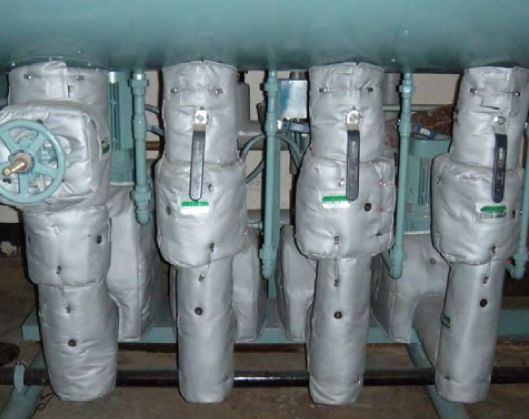Many companies (and managers) eagerly look for the next gadget (e.g., new electricity storage devices) or technology (e.g., low-cost solar mini-grid system) to enhance sustainability. But in doing so, they can overlook some under-the-radar approaches to achieving their green goals.
For example, insulating uncovered or poorly wrapped industrial components used by plants, refineries, healthcare systems, universities, and other industries reduces heat loss. Wrapping steam fittings, valves, and strainers with removable, reusable insulation blankets, is a low-cost measure that packs an outsized punch in terms of reducing a manufacturer’s carbon footprint. Similarly, there are ways to use reusable removable safety spray shields as protective enclosures around mechanical joints in liquid piping systems. Like their thermal insulation cousins, safety spray shields and safety fire blankets are a simple, sustainable way to mitigate environmental impact from leaky connections and maintain the operation of a MOV Valve during a fire .
Calculating the cost of these green solutions is often defined by payback, or the ROI. Customers who buy these removable, reusable thermal insulation blankets typically note the products pay for themselves in 7 to 36 months. For the thermal blankets, that payback comes from energy savings related to the cost of fuel (i.e., natural gas, electricity). Other customers calculate their payback by the cost per therm reaped from an insulation initiative.
Some naysayers argue that removable, reusable insulation often gets taken off by workers and not put back on a component. The design methodology helps reduce the time to reinstall the blankets. For instance, blanket shape and fasteners impact how quickly and easily a blanket is reinstalled. The likely hood of a blanket being reinstalled increases as the time to re-install it decreases. For instance, some competitors’ blankets might have multiple straps that would cause a maintenance worker to spend up to 10 minutes replacing them. A similarly designed blanket from Shannon might instead have three fasteners, requiring two or three minutes to secure. To remedy this, Shannon provides custom-fit blankets that a worker can easily remove and reinstall. Shannon also offers a service wherein its team returns to a customer’s facility annually to ensure all insulation blankets are in place and any removed get put back on the component they were designed for. Ensuring insulation is easily removed and reinstalled is a key to making sure blankets remain in place.
Getting started
All companies are short on bandwidth these days. Managers and workers loathe taking on another project such as identifying their uninsulated components or re-examining a steam system. So, time-strapped managers can ask Shannon to come to their facility. In one day, Shannon’s experts can perform a detailed audit that produces the straightforward steps for immediately saving energy and reducing CO2 and nitrogen oxide (NOx) stemming from improperly insulated (or uninsulated) components. For uninsulated components, Shannon creates a scope of work to get them covered, and its team also evaluates the condition of blankets on insulated components.
Sustainability more than energy-savings
Sustainability isn’t just about saving therms, though; it also extends to the workforce. Shannon performs safety audits at facilities to look at conditions such as burn-risks. Many facilities have uninsulated components that Shannon has measured to be up to 350 degrees Fahrenheit. Keeping workers safe relates to sustainability because it keeps the environment in which they work healthy and productive. Keeping the environment safe also includes, for instance, preventing or mitigating leaks or breaks in a flange on a pipeline where effluent sprays into a stream or groundwater. Shannon’s safety audits also offer recommendations for protecting the environment by applying products like its Safety Spray Shield to redirect effluent into a containment bed. Containment beds often include sensors to detect effluent and notify workers of a leak, and the Safety Spray Shield redirects the spray to the containment bed where sensors can detect the afluent.
Contact Shannon and take the work out of assessing and reaching your sustainability goals. In one day, Shannon can provide you a plan that thousands of customers from every industry around the world have taken advantage of.

